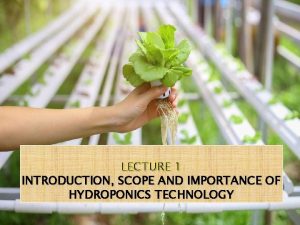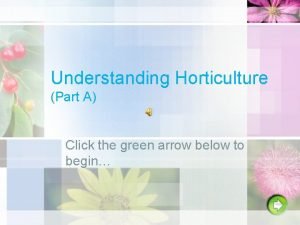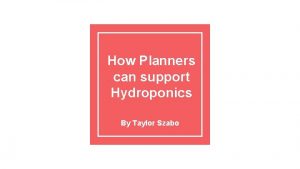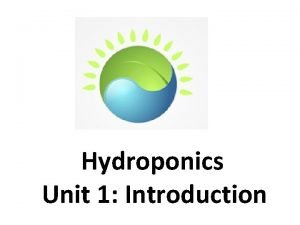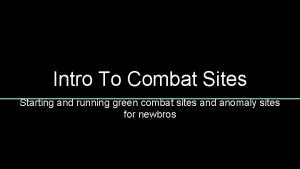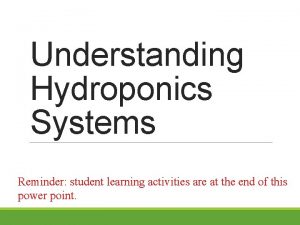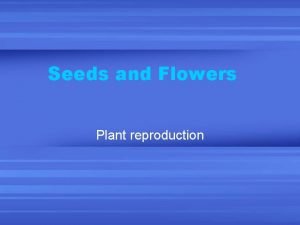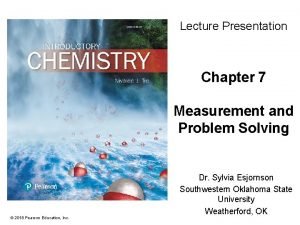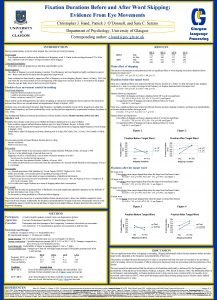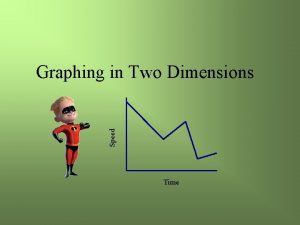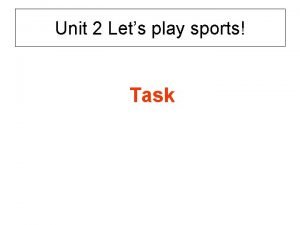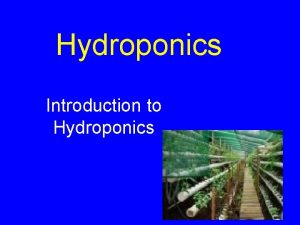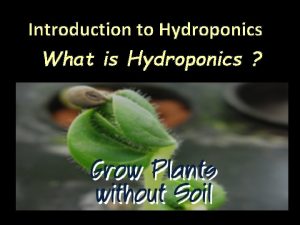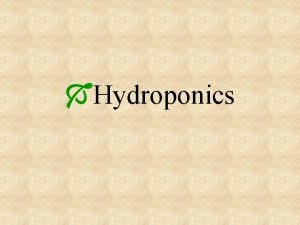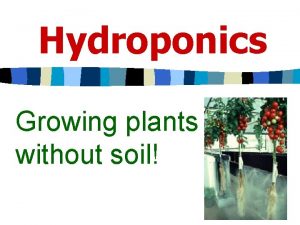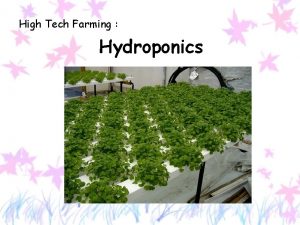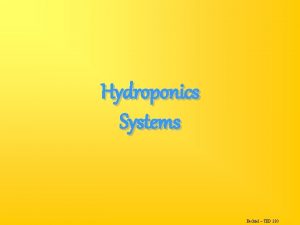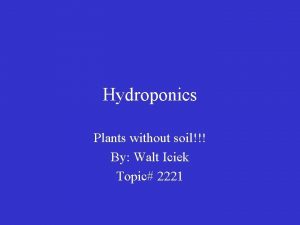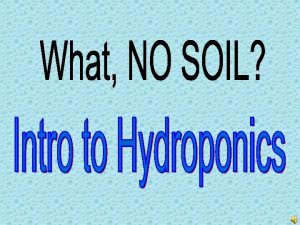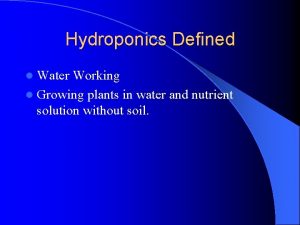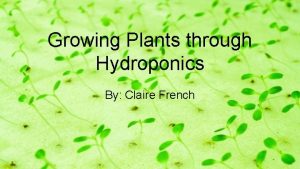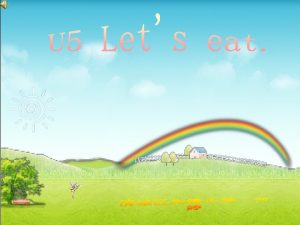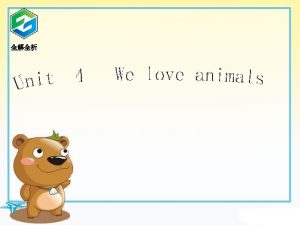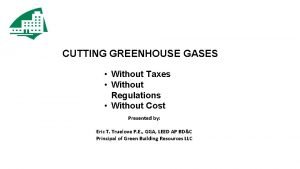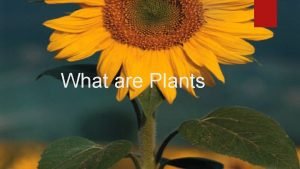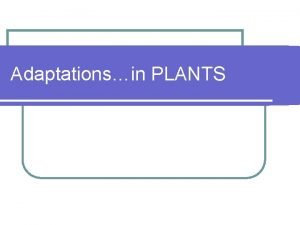Hydroponics Lets get growing Hydroponics Growing plants without
















































- Slides: 48

Hydroponics Let’s get growing

Hydroponics • Growing plants without soil


History • Began 70 years ago • Used to grow vegetables and flowers • In 1939, American Army installed hydroponic units on their military bases

Hydroponic: It’s easy • Have complete control of crop – – Water quality Air Nutrients Light

Hydroponics: Advantages • Does not harm environment • Great quality of crop = more money for your crop • Little water use • No weeds • Less space • Can be done anywhere • Can be done anytime • Automated

Aggregate culture • Using inert material to support and surround plants


Water Culture • Growing plants in water containing dissolved nutrients


Aeroponics • Growing of plants where the roots are suspended in a nutrient mist


Continuous-flow system • Nutrient solution flows constantly over plant roots, most commonly used for commercial production


Nutrient Solution • A solution of all essential nutrients needed for plant growth


Coconut Coir • Coconut husks ground up and compressed into a brick, used for a growing media


Rock Wool • Thin strand-like fibers made from rocks and formed into a brick, used for a growing media


Hydroton • Made of clay, shaped into pellets and used for a growing media


Vermiculite • Pieces of volcanic rock that expands and holds water, used as a growing media


Light • Sodium, Halogen, Fluorescent forms that supplement natural sunlight


Temperature • Indoor temperature must simulate natural temperatures of plant’s native habitat


Aeration • Providing oxygen to nutrient solution, can be done with aquarium pump


Crops • Typically grown: lettuce, tomatoes, herbs, peppers, cucumbers, and strawberries


p. H • A measurement that illustrates the acidity or alkalinity of a substance (plants need 5. 5 -7 for good growth)


Nutrient Film Technique • A plastic trough or tube supports plants and thin film of nutrient solution flows over roots


Aeration Method • Uses an air pump to bubble oxygen to the roots of plants immersed in the nutrient solution


Tube Culture • Plastic tube or bag is filled with lightweight aggregate, holes are made for plants and tube is hung vertically


Flood and Drain (Ebb and Flow) • Water-holdng container is filled with aggregate and plants, flooded periodically with the nutrient solution


Trickle Feed • Nutrient solution continuously pumped from the reservoir into smaller tubes and returned to reservoir


Garden Waves • Raleigh’s Hydroponics Store on Hillsborough St. near NCSU


Hydroponics: Disadvantages • Plant support is required • Water quality is important • Diseases spread through water • More moisture and humidity in air = more diseases • Expensive

Home Hydroponics Peeps
 Importance of hydroponics
Importance of hydroponics Get in get on get off get out
Get in get on get off get out Shot me out of the sky one direction
Shot me out of the sky one direction Lets get to know each other
Lets get to know each other Lets get started images
Lets get started images Mutually assured destruction cartoon
Mutually assured destruction cartoon Growing plants
Growing plants Taylor szabo
Taylor szabo Introduction to hydroponics
Introduction to hydroponics Serpentis den
Serpentis den Space engineers hydroponics
Space engineers hydroponics Hydroponics worksheet answers
Hydroponics worksheet answers Nonvascular plants definition
Nonvascular plants definition Vascular plants vs nonvascular plants
Vascular plants vs nonvascular plants C3 plant
C3 plant Classification of flowering and non flowering plants
Classification of flowering and non flowering plants How do plants get nitrogen
How do plants get nitrogen Chapter 6 cell energy photosynthesis and respiration
Chapter 6 cell energy photosynthesis and respiration Nitrogen rich soil
Nitrogen rich soil Pterophyta reproduction
Pterophyta reproduction Selection pseudocode
Selection pseudocode Get up get moving quiz
Get up get moving quiz Get focused get results
Get focused get results Get up get moving quiz
Get up get moving quiz Germer
Germer Get up get moving
Get up get moving Where to get free images without copyright
Where to get free images without copyright Without title diane glancy
Without title diane glancy Without a title poem
Without a title poem Why does pablo neruda urge to keep quiet
Why does pablo neruda urge to keep quiet Let's do the rooms
Let's do the rooms Plan lets go
Plan lets go Jeopardy game board
Jeopardy game board What is integers in maths
What is integers in maths Lets remember
Lets remember Lets remember
Lets remember Let's be good friends you and i
Let's be good friends you and i Lets be copd
Lets be copd Bing recycling quiz
Bing recycling quiz The word-skipping technique lets you figure out
The word-skipping technique lets you figure out Let's talk about sports
Let's talk about sports Taxi guanaco
Taxi guanaco Lets livingston county
Lets livingston county Lets spread the word
Lets spread the word Lets decide
Lets decide A train pulls into a station and lets off its passengers
A train pulls into a station and lets off its passengers Answer the questions two of the sports
Answer the questions two of the sports Lets play sports
Lets play sports Lets practice
Lets practice
